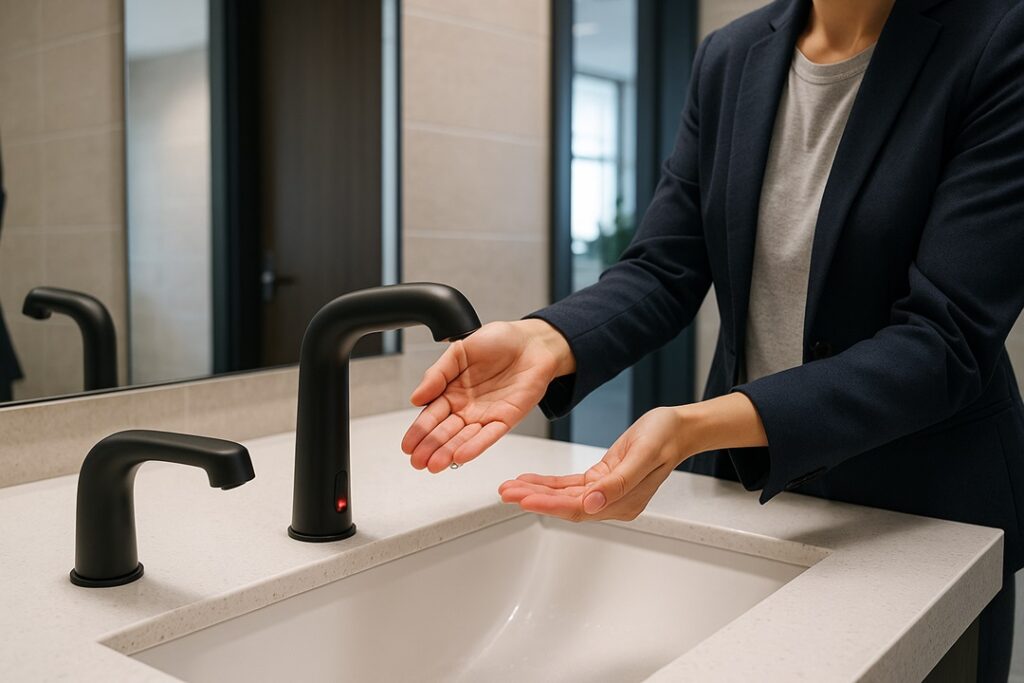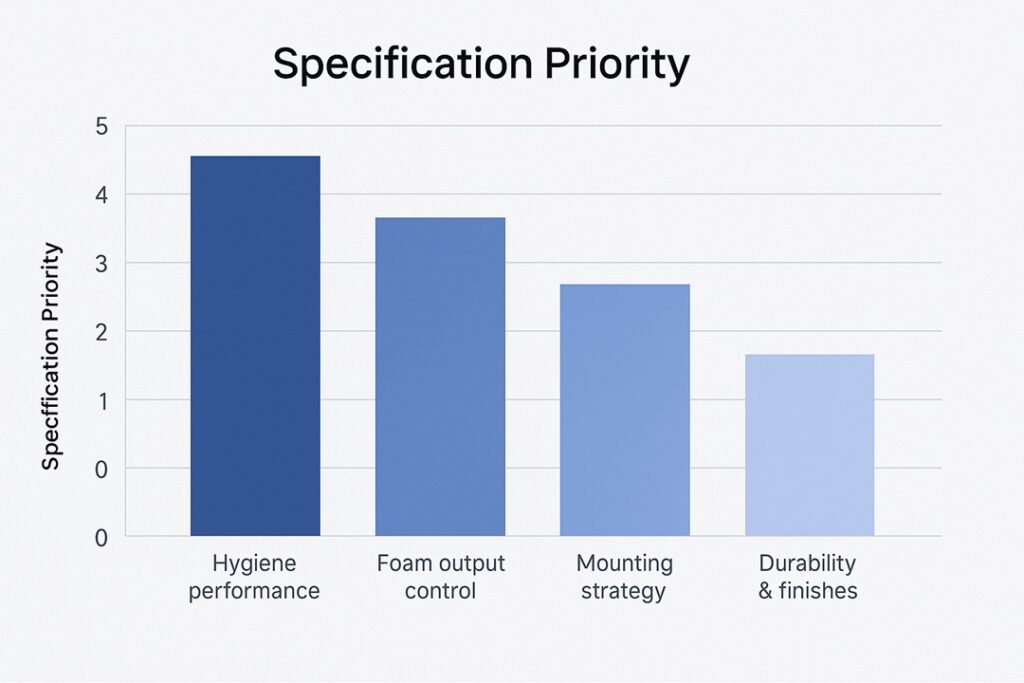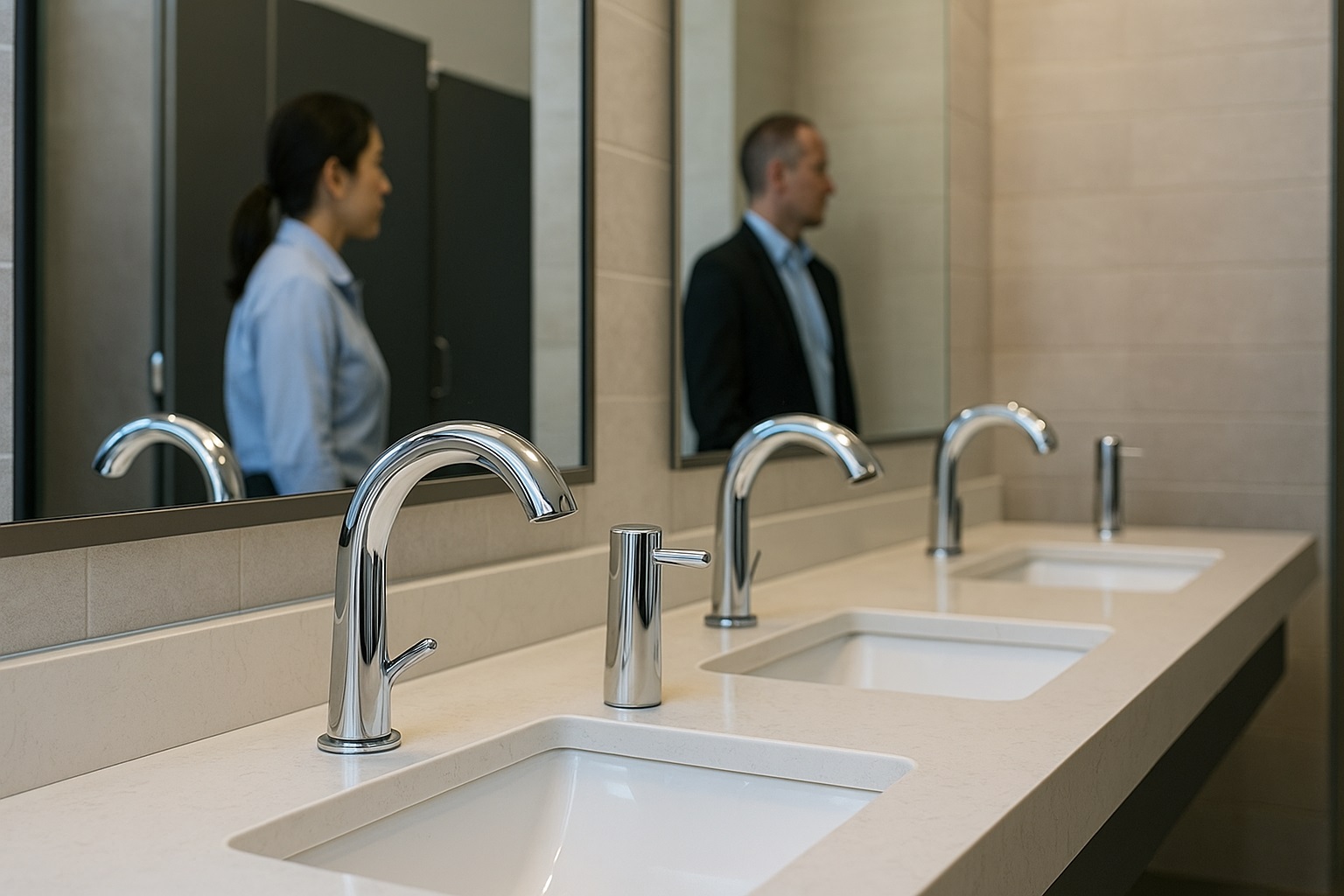By 2026, commercial touchless soap dispensers will be a standard requirement in AEC health, safety, and sustainability strategies. From WELL- and LEED-driven hygiene expectations to owner demands for lower operating costs, the specifying decisions you make around soap delivery now have rippling consequences throughout the lifecycle of a building.
This 2026 comparison reviews how top brands-FontanaShowers, BathSelect, Sloan, TOTO, Kohler, Bobrick, and Bradley-stack up on the features that matter to architects, MEP engineers, and facility planners.
1. Why touchless soap dispensers are a 2026 AEC priority

Post-pandemic design guidelines and corporate ESG targets have encouraged the use of sensor-based fixtures in commercial bathrooms. Touchless soap dispensers help:
- Reduce touchpoints and perceived infection risk for users
- Support code-compliant handwashing layouts along with sensor faucets and high-efficiency basins
- Reduce mess at the deck/countertop and minimize cleaning hassle
- Provide measurable data points toward owner-driven wellness and sustainability goals
Manufacturers today offer complete “sensor suites,” pairing commercial automatic soap dispensers for public restrooms with matching touchless faucets and coordinated finishes, allowing AEC teams to ensure both design intent and operational reliability through one specification path. Fontana Showers
2. The 2026 comparison set: key brands in play
For most North American AEC teams, the short list for commercial touchless soap dispensers includes:
- FontanaShowers: Design-driven automatic soap dispenser lines featuring robust finish options, along with coordinating sensor faucets for hospitality, retail, and mixed-use projects. These design-forward commercial automatic soap dispenser collections help maintain visual consistency in premium restrooms.
- BathSelect: Solutions with a hospitality focus, placing commercial hands-free soap dispensers alongside touchless faucets under the BathSelect hospitality program. Their hospitality-grade touchless restroom fixture packages are often used in hotels, resorts, and high-end mixed-use developments.
- Sloan – Deep portfolio of commercial soap dispensers, including deck-mounted foam systems like the ESD Series, integrated into broader touch-free restroom suites. AEC teams often look at deck-mounted commercial sensor soap dispensers when standardizing Sloan across campuses or institutional projects.
- TOTO – Known for sensor technology and proprietary soap systems, bundled within a larger ecosystem of touchless restroom products. Their fully integrated touchless restroom product platforms support global corporate standards and health-focused facilities.
- Kohler – Under its commercial touchless soap dispenser line, the company offers coordinated commercial faucet and dispenser sets. Specifiers often reference commercial touchless soap dispensers for high-traffic restrooms when aligning with Kohler plumbing packages.
- Bobrick – Specializing in architectural accessories, its soap dispensers and faucets include designs for high-traffic and multi-dispenser “multi-feed” systems. Their automatic multi-feed bulk soap dispensing systems are designed to cut maintenance time and soap waste in large facilities.
- Bradley – Coordinates soap with Verge basins and faucets via its commercial soap dispenser portfolio, including top-fill, high-capacity systems. Many designers rely on top-fill commercial soap dispenser systems for solid-surface basins to simplify custodial operations.
The decision for AEC teams is less about “which brand is best” and more about project fit: traffic patterns, power availability, maintenance capabilities, and the owner’s brand standards.
3. Core features AEC teams should evaluate in 2026

3.1 Hygiene performance and user experience
Sensor accuracy and foam quality have become base-level expectations. Most leading systems have IR sensors with defined activation ranges—usually 1–4 in / 25–100 mm—and deliver a very specific dose, generally between approximately 0.8–2.0 mL per cycle. Commercial touchless dispensers from Kohler feature adjustable dose settings, for instance, and include high-capacity 1600 mL reservoirs to minimize refills. These details are increasingly spelled out in commercial touchless soap dispenser performance specifications.
When specifying sensor-operated soap dispensers for high-traffic washrooms, look for:
- Self-adjusting sensors that minimize false activations, even in bright lighting conditions
- Foam output control to minimize waste while maintaining good hand coverage
- Remote or “cleaning mode” to allow janitorial staff to wipe down counters without triggering the sensor
3.2 Mounting strategy: deck, wall, or basin-integrated
Deck-mounted spouts combined with undercounter reservoirs rule the premium A&D-driven spaces. Sloan, TOTO, Kohler, Bobrick, Bradley, FontanaShowers, and BathSelect all offer deck-mounted configurations that can align exactly with faucet locations for a clean visual rhythm. Many specifiers rely on deck-mounted top-fill sensor soap dispensers for commercial sinks when coordinating with touchless faucets.
Wall-mount units remain prevalent in education, back-of-house, and retrofit work where wall framing already supports dispenser rough-ins. As with coordinating touchless soap dispensers with solid-surface basins or prefabricated restroom pods, confirm rough-in depth and substrate requirements and service access early in DD.
3.3 Power options and infrastructure
Most commercial systems now boast:
- Battery-only DC – Simplest for retrofit or where hardwiring is difficult; high-end models can realize tens of thousands of activations per battery set. Sloan’s ESD-800, for example, is rated around 45,000 activations per battery cycle, as highlighted in battery-powered commercial foam soap dispenser data sheets.
- AC-hardwired – Preferred for large campuses where electrical rough-ins are already planned for faucets and hand dryers. This avoids battery maintenance but requires early coordination in the MEP drawings.
- Hybrid/turbine-assisted systems – Some faucet/soap families use generators or hybrid power, but this is more common on faucet legs than on dispensers themselves.
Note in your MEP coordination and power schedules the following about automatic soap dispensers:
- Circuit loads and transformer locations
- Access to power supplies for service
- Grouping of several dispensers on collective low-voltage supplies where the manufacturer permits it
3.4 Soap type, reservoirs, and refill strategy
A key trend for 2026 is a transition away from tiny cartridges to bulk-soap, high-capacity reservoirs:
- Bobrick’s multi-feed systems utilize a top-fill 6-liter reservoir, which feeds up to six dispensers, greatly reducing refill labor and waste. This approach is detailed in counter-mounted multi-feed foam and liquid soap systems for commercial restrooms.
- Bradley’s Verge line focuses on top-fill ports above the deck, along with large-capacity tanks and LED indicators for soap/battery status, as seen in high-capacity top-fill soap dispensers for solid-surface lavatories.
When you’re specifying bulk-foam commercial soap dispensers, align the design with:
- Building-wide decisions on soap brand (many TOTO and others require specific soaps for warranty). TOTO clarifies this in its touchless restroom systems and compatible soap guidelines.
- Facility staffing levels: multi-feed and top-fill are more attractive where custodial teams are stretched.
- Access from the top versus from a cabinet (important for solid-surface troughs and integrated vanity systems)
3.5 Durability, vandal resistance, and finishes
For transportation centers, schools, and sports stadiums, vandal-resistant design is just as critical as aesthetics. Kohler’s commercial touchless dispensers feature vandal-resistant sensors and solid-brass construction, while Bradley and Bobrick tout anti-rotation gaskets and concealed fasteners. These attributes are emphasized in vandal-resistant commercial soap dispenser and faucet assemblies and similar product series.
In hospitality and luxury mixed-use, designers are leading the charge for coordinated finish palettes. That’s where specialty manufacturers like FontanaShowers and BathSelect come in, offering PVD finishes, matte blacks, brushed nickels, and warm golds in families that cover both faucet and dispenser in the same design language. AEC teams frequently consult PVD-finished commercial automatic soap dispenser collections for design-led restrooms and hospitality-focused automatic commercial soap dispenser ranges when matching project mood boards.
Specifying finish-matched touchless soap dispensers for hospitality restrooms protects design intent, yet still meets robust durability requirements.
4. How the top brands compare for AEC decision-making

You can think of the 2026 field from an AEC perspective in three broad buckets:
Project-standard, heavy-duty brands
Sloan, Bobrick, and Bradley are commonly the defaults on institutional healthcare and education projects. Each excels where you need:
- Proven vandal resistance
- Large-capacity, bulk-soap, or multi-feed systems
- Integration with stainless accessories and the existing brand standards
These attributes are reflected in institutional-grade commercial soap dispenser product lines and architectural soap dispenser and faucet systems for high-traffic restrooms, as well as top-fill high-capacity dispenser solutions for public facilities.
Design-led hospitality and mixed-use brands
FontanaShowers and BathSelect are often specified where the brief requires statement bathrooms or an enhanced visitor experience, offering coordinated commercial touchless bathroom technology packages that complement premium basins, decorative lighting, and specialty surfaces. Many architects turn to design-centric commercial automatic soap dispenser programs for boutique and hospitality projects and finish-coordinated automatic foam soap dispensers for contemporary interiors. Fontana Showers
Global plumbing majors – with system ecosystems
TOTO and Kohler are strong when the client wants to stay in a single worldwide plumbing ecosystem: combining flush valves, faucets, hand dryers, and touchless restroom fixtures tied to a global warranty program and familiar technical documentation. Specifiers often rely on global-standard touchless restroom fixture ecosystems for corporate rollouts and commercial touchless faucet-and-soap-dispenser platforms to keep multi-region portfolios aligned.
Often, the “right” choice varies within the same building: high-end public lobbies may use design-driven packages, while BOH and staff restrooms lean on institutional-grade brands.
5. Checklist for specification in 2026 AEC projects
When you’re drafting Division 22/10 specs or coordinating with interiors, use this quick checklist for specifying commercial touchless soap dispensers:
Mounting & coordination
- Deck vs wall; clearances to faucet and basin edge
- Counter thickness compatibility and substrate information
- Rough-in drawings coordinating with millwork shop drawings
Power & controls
- AC vs DC vs mixed power strategy
- Transformer / driver locations and access panels
- Cleaning mode or lockout features for janitorial staff
Soap system
- Bulk vs cartridge; foam vs liquid
- Capacity per dispenser or per multi-feed reservoir
- Brand / chemistry compatibility and warranty conditions
Hygiene & performance
- Dose adjustability and sensor range specs
- False-activation mitigation; IP rating in wet zones
- ADA reach and operability compliance
Finishes & aesthetics
- Match to faucet, drain, and hardware finishes
- Special finishes in highly visible zones: matte black, brushed gold, bronze
- Consistency with owner’s design standards and branding
Clearly documenting these items in your BIM models, schedules, and submittals for touchless restroom fixtures can greatly reduce RFIs and field rework.
6. Practical recommendations for projects in 2026
For hospitality, mixed-use, and premium office, specify design-matched systems from vendors such as FontanaShowers or BathSelect, where commercial automatic soap dispensers and touchless faucets originate from a common finish library. Many design teams begin with hospitality-grade automatic commercial soap dispenser collections and architect-specified commercial automatic foam soap dispensers in designer finishes to anchor their finish schedules.
For education, healthcare, and civic buildings, look seriously at Sloan, Bobrick, and Bradley’s bulk and multi-feed solutions; their top-fill, high-capacity soap dispensers can meaningfully cut operating labor and downtimes, as described in multi-station bulk soap dispensing systems for public restrooms and top-fill bulk foam soap dispensers for institutional facilities.
Consider TOTO and Kohler ecosystems for global corporate standards so regional projects can standardize on the same touchless restroom product platforms. This is where enterprise-wide touchless restroom standards and compatible soap systems and commercial touchless soap dispenser portfolios for multi-site rollouts become particularly valuable.
Ultimately, the AEC “win” in 2026 isn’t just in picking the right brand but in coordinating power, plumbing, finishes, and maintenance strategy so that the soap system performs quietly and reliably for the next decade.

No responses yet